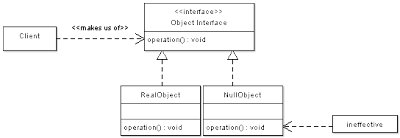Very often you create a object with a factory and before you really start using it, you check if your factory really created a object or returned NULL. Or maybe you have a method where a object is passed in and in this situation you’ll have to do this check also.
Instead of typing the “if(object == null)” phrase again and again, you could use the Null-Object pattern, you’ll see that this can make some situations much clearer.
Basically Null-Object ensures that the client always receives a valid object for it’s interaction, so that there’s no need to do the check shown above again and again. This happens since your concrete Null-Object just shares the interface, or inherits from the same class as it’s effective counterpart, but it’s implementation just leaves out any effectiveness.
 So a code-example could look like this:
So a code-example could look like this:
class CookieFactory {
public function makeInstance() {
if(date(‘l’)==‘Monday’) return new NullCookie();
return new RealCookie();
}
}
interface iCookie {
function getCalories();
}
class RealCookie implements iCookie {
protected $calories=250;
public function getCalories() {
return $this->calories;
}
}
class NullCookie implements iCookie {
public function getCalories() {
return 0;
}
}
I think you can imagine what happens when you make use of the CookieFactory - diet on monday ;)
There’re also some disadvantages, your clients normally don’t have a chance to react that there’s something special happening, also the clients must “share” the same expectation what “do nothing” means, the number of required Null-Objects might be very large and unhandy and the Null-Object shares a very deep knowledge with the real one, so that it might be a large effort to create it if the real object is complex too.
I’m so glad that today is tuesday :P